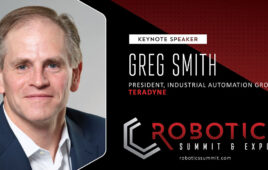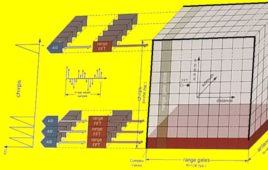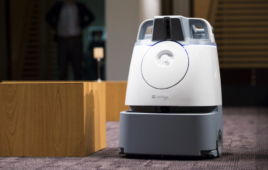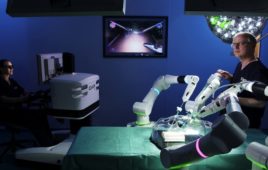
Hyundai is using the H-CEX industrial exoskeletons to relieve worker stress.
Many of the most visible demonstrations of exoskeletons have been for assisting people with disabilities. However, limitations of weight, power, and cost have resulted in slow rates of adoption. In the meantime, the technology continues to advance, with industrial exoskeletons providing application experience.
While the majority of today’s $130 million wearable robotics market is for medical exoskeletons, industrial exoskeletons are growing in number, as is the number of providers, reported Wintergreen Research Inc.
For example, Hyundai Motor Group has been testing in a North American Kia factory its Hyundai Vest Exoskeleton (H-VEX), which is designed to reduce pressure on workers’ necks and backs. Its Hyundai Chairless Exoskeleton (H-CEX) assists sitting workers and is meant to relieve knee stress.
Sarcos offers full-body industrial exoskeleton
In November, Sarcos Robotics unveiled its Guardian XO Max, a “full-body, powered industrial exoskeleton robotic system.” It’s obviously bigger and bulkier than wearable technologies designed for hospital or home use, but such commercial use cases will provide valuable data.
“There are many misperceptions regarding the commercial readiness and viability of full-body industrial exoskeletons that are capable of substantially increasing human strength and endurance, including the amount of power required to operate these machines,” said Ben Wolff, chairman and CEO of Salt Lake City-based Sarcos.
Sarcos’ latest industrial exoskeleton is able to run for up to eight hours on a single charge, has “hot-swappable” batteries, and uses a “Get-Out-of-the-Way” control system that’s designed to follow its operator’s lead rather than need lots of sensors. With a strength amplification of 20 to 1, the Guardian XO Max can help users lift 200 pounds, and is intended for construction sites.
Back injuries cost U.S. employers more than $100 billion per year, so avoiding injury is just as important as enhancing strength, noted Sarcos. The company raised a $30 million Series B round of funding last September.
“Sarcos’ Guardian XO Max will be a game-changer for the industrial workforce, improving strength and capabilities, reducing the risk of injury on the job, and increasing the quality of life and longevity of workers,” predicted IDC analyst John Santagate. The industrial exoskeleton will be available later this year under a robots-as-a-service (RaaS) model and will ship to the first customers in early 2020.
The U.S. Special Operations Command is working with Sarcos on the Tactical Assault Light Operator Suit (TALOS), an exoskeleton designed to protect forces from small arms fire while providing support for strenuous activities. The U.S. military is also working with Lockheed Martin and other contractors to develop wearable robotics.
International interest in industrial exoskeletons
In addition to increasing lifting capacity and minimizing physical stress, another driver for the growth in industrial exoskeletons is an aging labor pool and a shortage of qualified replacements.
Global demand for industrial exoskeletons is already strong. ABI Research stated that the total addressable market for industrial exoskeletons exceeds 2.6 million units and that shipments will grow from 7,000 units in 2018 to 301,000 by 2028, with revenue of $5.8 billion by 2028.
Ekso Bionics Inc. last month signed a $100 million joint-venture agreement with venture capital firms in China to build manufacturing facilities there and expand its marketing efforts. The company previously sold 75 EksoVest industrial exoskeletons to Ford for use in two plants in Dearborn, Mich. It was the largest adoption of industrial exoskeletons to date.
German prosthetics maker Ottobock also plans to sell industrial exoskeletons. Eighty percent of people who tried the Paexo exoskeleton for overhead work at a Volkswagen plant in Bratislava said they would recommend it to colleagues.
Comau SpA developed its Muscular Aiding Tech Exoskeleton (MATE) with Iceland-based ÖSSUR and Italy-based IUVO. MATE is designed to be lightweight, easy to use, and suitable for tasks such as restocking shelves.
Similarly, automakers including BMW, Ford, and Hyundai are already using San Diego-based Levitate Technologies Inc.‘s AIRFRAME exoskeleton. Each of these industrial exoskeletons advances the state of the art for weight, battery duration, and responsiveness.
Industrial, medical markets both advance
The medical exoskeleton market will likely benefit from the spread of industrial exoskeletons. ReWalk Robotics’ announcement last week that Cigna Corp. will reimburse exoskeleton expenses for people with spinal cord injuries demonstrates the progress being made. Israel-based ReWalk has also applied for FDA approval of its ReStore exoskeleton for stroke rehabilitation.
Fourier Intelligence Co. is developing its Fourier X2 open platform to be more affordable than the competition.
“The new Fourier X2 is lighter, with better materials to make it more wearable,” said Zen Koh, deputy CEO of the Shanghai-based company. “The application can be used in research, education, different augmentation application purposes, and industrial use.
Filed Under: The Robot Report





Tell Us What You Think!